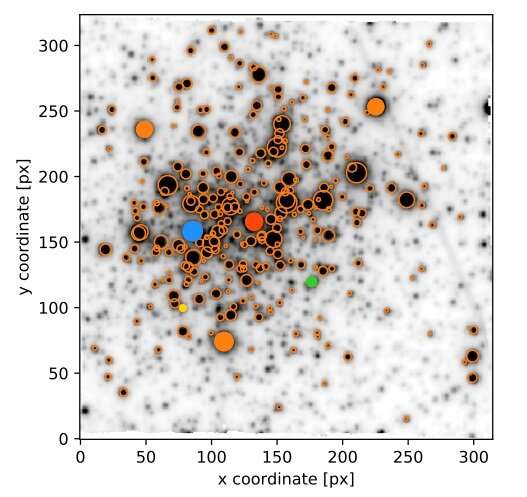NGC 330: Stars contained in the final target list overplotted in orange over the MUSE white light image. Credit: Bodensteiner et al., 2019.
Using the Multi-Unit Spectroscopic Explorer (MUSE) at the Very Large Telescope (VLT) in Chile, astronomers have conducted a spectroscopic study of the young open cluster NGC 330. Results of the research, published on arXiv.org, provide more details about the cluster's stellar content.
Located some 196,000 light years away in the Small Magellanic Cloud (SMC), NGC 330 is an open cluster estimated to be between 26 and 45 million years old. The cluster has a dynamical mass of about 158,000 solar masses, and is assumed to contain many so-called binary-interaction products (BiPs)—objects affected by the interaction of massive stars in binary systems.
BiPs are believed to be common in stellar populations, especially in young clusters, and could be crucial to help us better understand the process of stellar evolution. Given that the properties of BiPs are still not well constrained, more studies are needed to resolve the remaining uncertainties about these objects.
Recently, a team of astronomers led by Julia Bodensteiner of the Catholic University of Leuven in Belgium, has decided to identify and characterize a sample of BiPs in NGC 330. Using MUSE, they managed to resolve the cluster's dense core for the first time and to extract spectra of its entire massive stellar population.
"This is a first study of the dense core of the SMC cluster NGC 330 using the MUSE-WFM [wide-field mode] equipped with the new AO [adaptive optics]. The unprecedented spatial resolution of MUSE WFM-AO allows us to spectroscopically study the massive star population in the dense core of the cluster for the first time," the astronomers wrote in the paper.
As noted in the study, MUSE allowed the researchers to characterize the massive star content of the core of NGC 330. They found that it contains more than 200 B stars, two O stars, six A-type supergiants and 11 red supergiants.
According to the paper, about 30 percent of the studied B stars in the core of NGC 330, as well as the two O stars, show broad spectral lines. This suggests rapid rotation and emission features primarily in hydrogen-alpha, but also in other spectral lines (He I and O I), which allowed the researchers to classify these objects as classical Be (Oe) stars. However, the fraction of Be stars in the sample is even higher (about 46 percent), when considering only stars brighter than 17 mag.
The results also delivered more insights into the mass of NGC 330 and the age of its core. It was found that the total mass of the cluster is approximately 88,000 solar masses, while its core is between 35 and 40 million years old.
By comparing the new data to previous studies, the astronomers found that the stellar content of the core clearly differs from that observed in the cluster's outskirts.
"While the stellar content in the core appears to be older than the stars in the outskirts, the Be star fraction and the observed binary fraction are significantly higher," the scientists noted.
Trying to explain the two distinct populations in NGC 330, the authors of the paper assume that it could be due to different star-formation histories, with the older cluster contrasting with younger stars formed as part of the ongoing star formation in the bar of the Small Magellanic Cloud. Bodensteiner's team plans to investigate the star-formation history of NGC 330 in future studies.
More information: The young massive SMC cluster NGC 330 seen by MUSE. I. Observations and stellar content, arXiv:1911.03477 [astro-ph.SR] arxiv.org/abs/1911.03477
© 2019 Science X Network
























